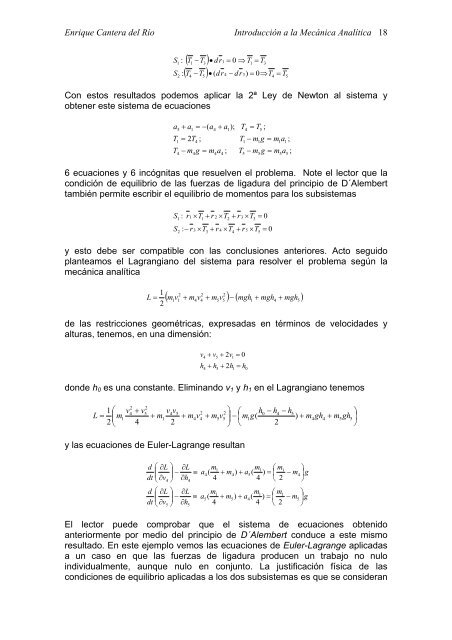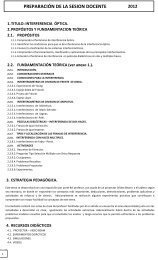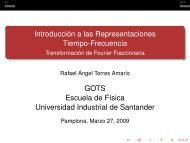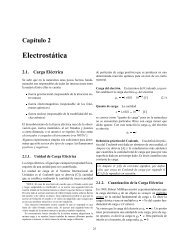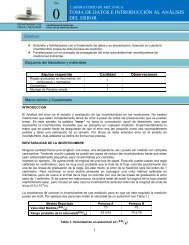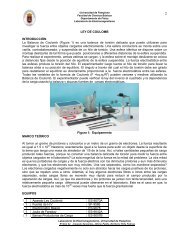introducción a la mecánica analítica - fisica.ru
introducción a la mecánica analítica - fisica.ru
introducción a la mecánica analítica - fisica.ru
Create successful ePaper yourself
Turn your PDF publications into a flip-book with our unique Google optimized e-Paper software.
Enrique Cantera del Río Introducción a <strong>la</strong> Mecánica Analítica 18<br />
S<br />
S<br />
1<br />
2<br />
:<br />
( T1<br />
− T3<br />
) • dr<br />
1 = 0 ⇒ T1<br />
= T3<br />
( T4<br />
− T5<br />
) • ( dr<br />
4 − dr<br />
3)<br />
= 0⇒T4<br />
= T5<br />
:<br />
Con estos resultados podemos aplicar <strong>la</strong> 2ª Ley de Newton al sistema y<br />
obtener este sistema de ecuaciones<br />
a + a = −(<br />
a + a ); T = T ;<br />
5<br />
1<br />
4<br />
1<br />
T = 2T<br />
;<br />
4<br />
4<br />
T − m g = m a ;<br />
4<br />
4<br />
4<br />
1<br />
T − m g = m a ;<br />
1<br />
5<br />
4<br />
1<br />
5<br />
5<br />
T − m g = m a ;<br />
6 ecuaciones y 6 incógnitas que resuelven el problema. Note el lector que <strong>la</strong><br />
condición de equilibrio de <strong>la</strong>s fuerzas de ligadura del principio de D´Alembert<br />
también permite escribir el equilibrio de momentos para los subsistemas<br />
S : r1<br />
× T + r 2 × T + r 3 × T = 0<br />
1<br />
2<br />
1<br />
S : − r 3 × T + r 4 × T + r 5 × T = 0<br />
3<br />
y esto debe ser compatible con <strong>la</strong>s conclusiones anteriores. Acto seguido<br />
p<strong>la</strong>nteamos el Lagrangiano del sistema para resolver el problema según <strong>la</strong><br />
<strong>mecánica</strong> <strong>analítica</strong><br />
2<br />
4<br />
2 2 2<br />
( m v + m v + m v ) − ( mgh + mgh mgh )<br />
1<br />
L = 1 1 4 4 5 5<br />
1 4 +<br />
2<br />
de <strong>la</strong>s restricciones geométricas, expresadas en términos de velocidades y<br />
alturas, tenemos, en una dimensión:<br />
v4<br />
+ v5<br />
+ 2v1<br />
= 0<br />
h + h + 2h<br />
= h<br />
4<br />
donde h0 es una constante. Eliminando v1 y h1 en el Lagrangiano tenemos<br />
5<br />
2 2<br />
1 ⎛ v<br />
⎞<br />
4 + v5<br />
v4v5<br />
2 2 ⎛ h0<br />
− h4<br />
− h5<br />
⎞<br />
L = ⎜<br />
⎜m1<br />
+ m1<br />
+ m4v4<br />
+ m5v5<br />
⎟ − ⎜m1<br />
g(<br />
) + m4gh4<br />
+ m5gh5<br />
⎟<br />
2 ⎝ 4 2<br />
⎠ ⎝ 2<br />
⎠<br />
y <strong>la</strong>s ecuaciones de Euler-Lagrange resultan<br />
d ⎛ ∂L<br />
⎞ ∂L<br />
m1<br />
m1<br />
⎛ m1<br />
⎞<br />
− ≡ a + m + a = ⎜ − m ⎟g<br />
dt ⎜<br />
v ⎟<br />
4(<br />
4)<br />
5(<br />
)<br />
4<br />
⎝ ∂ 4 ⎠ ∂h4<br />
4<br />
4 ⎝ 2 ⎠<br />
d ⎛ ∂L<br />
⎞ ∂L<br />
m1<br />
m1<br />
⎛ m1<br />
⎞<br />
− ≡ a + m + a = ⎜ − m ⎟g<br />
dt ⎜<br />
v ⎟<br />
5(<br />
5)<br />
4(<br />
)<br />
5<br />
⎝ ∂ 5 ⎠ ∂h5<br />
4<br />
4 ⎝ 2 ⎠<br />
El lector puede comprobar que el sistema de ecuaciones obtenido<br />
anteriormente por medio del principio de D´Alembert conduce a este mismo<br />
resultado. En este ejemplo vemos <strong>la</strong>s ecuaciones de Euler-Lagrange aplicadas<br />
a un caso en que <strong>la</strong>s fuerzas de ligadura producen un trabajo no nulo<br />
individualmente, aunque nulo en conjunto. La justificación física de <strong>la</strong>s<br />
condiciones de equilibrio aplicadas a los dos subsistemas es que se consideran<br />
1<br />
0<br />
3<br />
5<br />
1<br />
5<br />
1<br />
5<br />
5


